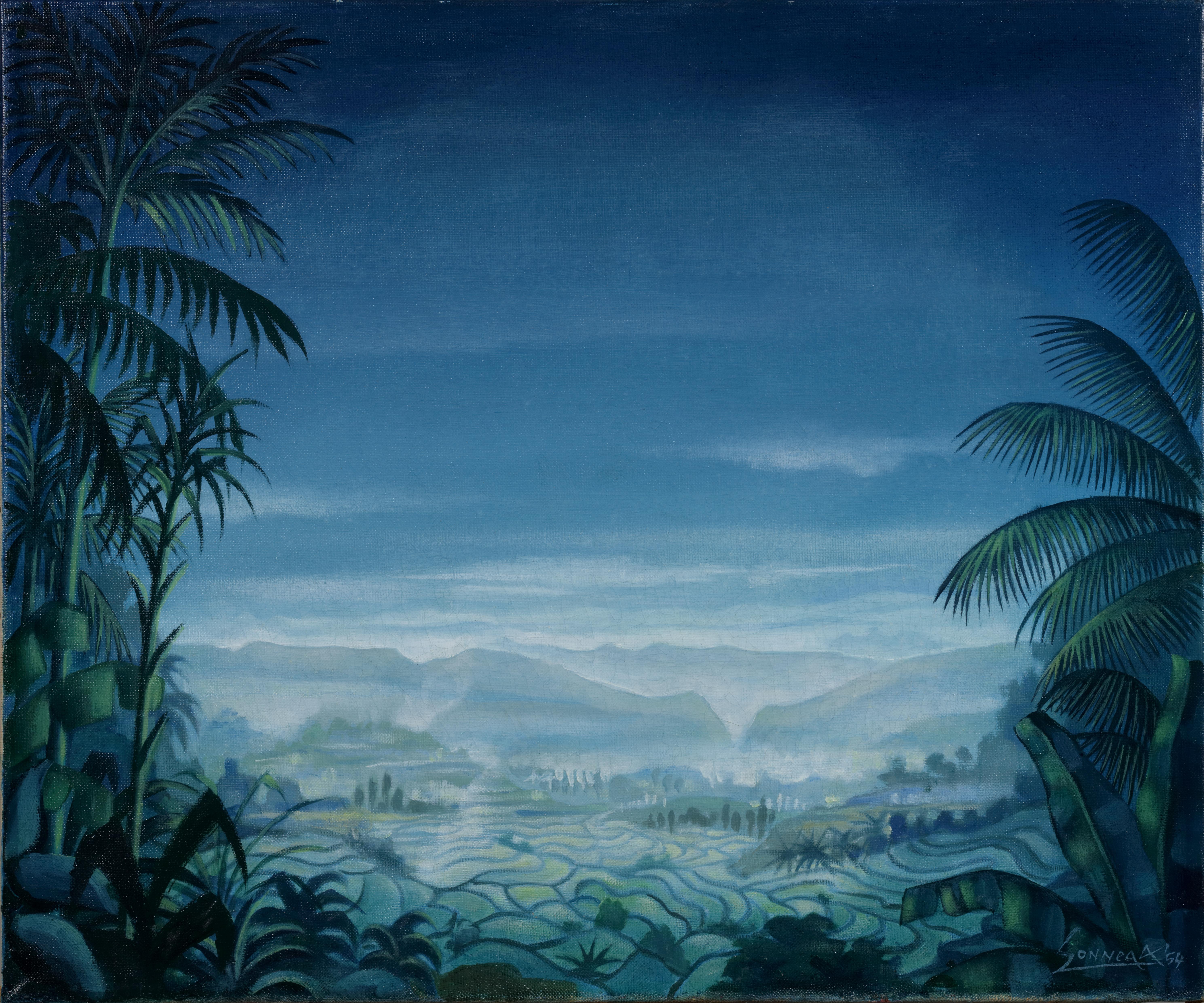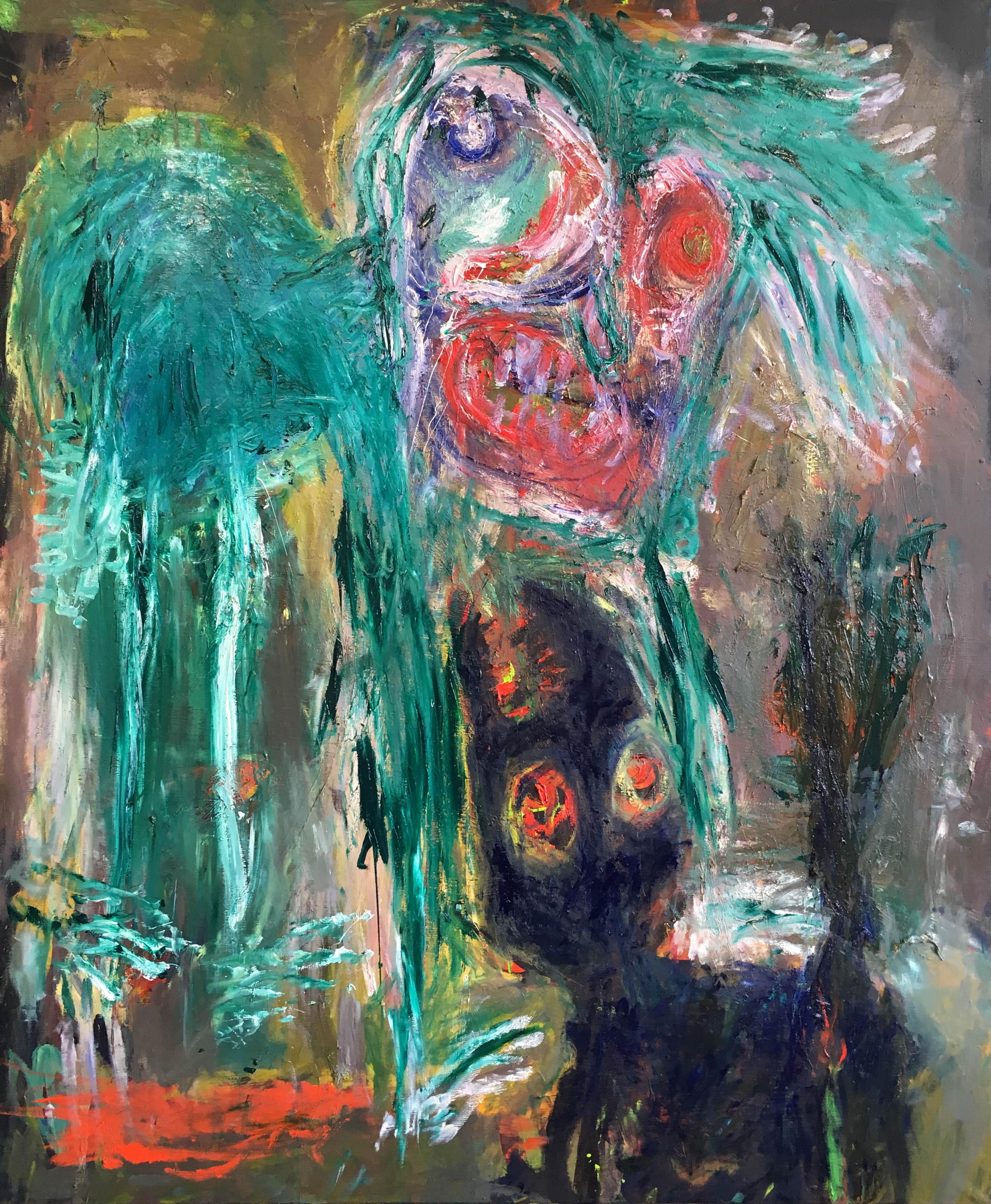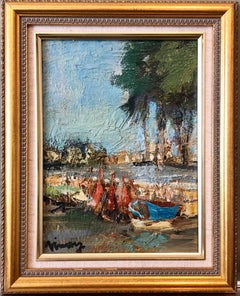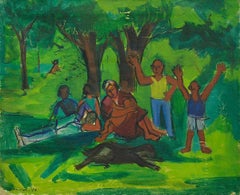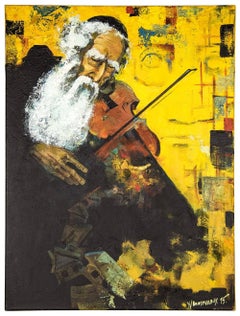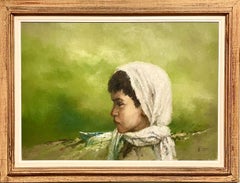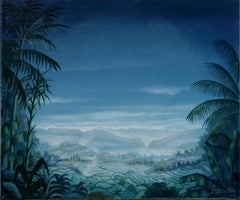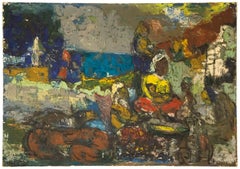
Resting at Evening, Israeli Modernist Painting
View Similar Items
Want more images or videos?
Request additional images or videos from the seller
1 of 5
Abraham CohenResting at Evening, Israeli Modernist Painting1963
1963
$1,200List Price
About the Item
- Creator:Abraham Cohen (Israeli)
- Creation Year:1963
- Dimensions:Height: 26 in (66.04 cm)Width: 22 in (55.88 cm)
- Medium:
- Movement & Style:
- Period:
- Condition:
- Gallery Location:Surfside, FL
- Reference Number:1stDibs: LU3822063803
About the Seller
4.9
Platinum Seller
Premium sellers with a 4.7+ rating and 24-hour response times
Established in 1995
1stDibs seller since 2014
1,777 sales on 1stDibs
Authenticity Guarantee
In the unlikely event there’s an issue with an item’s authenticity, contact us within 1 year for a full refund. DetailsMoney-Back Guarantee
If your item is not as described, is damaged in transit, or does not arrive, contact us within 7 days for a full refund. Details24-Hour Cancellation
You have a 24-hour grace period in which to reconsider your purchase, with no questions asked.Vetted Professional Sellers
Our world-class sellers must adhere to strict standards for service and quality, maintaining the integrity of our listings.Price-Match Guarantee
If you find that a seller listed the same item for a lower price elsewhere, we’ll match it.Trusted Global Delivery
Our best-in-class carrier network provides specialized shipping options worldwide, including custom delivery.More From This Seller
View AllFrench Expressionist Ecole de Paris Oil Painting Boats on French Riviera
By Jean Vinay
Located in Surfside, FL
Jean Vinay was a self-taught artist though he received artistic guidance from Albert Marquet, the Fauvist, who he knew through his travels in French North Africa. Jean Viney...
Category
20th Century Expressionist Landscape Paintings
Materials
Canvas, Oil
Modernist Family Outing with Dog (Picnic in the Park) Ben Benn Oil Painting WPA
By Ben Benn
Located in Surfside, FL
Genre: Modern
Subject: People
Medium: Acrylic
Surface: Canvas
Country: United States
Dimensions: 20" x 24"
Scene of a family leisurely gathering together in a park to picnic and enjoying their day by the artist Ben Benn.
Ben Benn, Russian/American (1884-1983)
Ben Benn, a Russian-born American still-life and Post Impressionist landscape painter who was part of the first generation of artists in America to try to digest the lessons of Cubism Benn Benn was a pioneer American modernist whose independent style defied stylistic classification. Despite excursions into Cubism and Abstract Expressionist style, Benn “seems always to have been a ‘subject’ painter. Considering this, it is remarkable that he remained visible at all during the 50’s and early 60’s, when prejudice against the representational amounted nearly to a proscription of it.” Benn’s prominence in the art world over 6 decades was reaffirmed at a 90th birthday show at the Hirshhorn Museum in Washington , D.C. in 1974.
Benn was born Benjamin Rosenberg in the town of Kamenets Podolsk in the Russian empire in 1884. This town was the regional capital of an area in what is today, SW Ukraine, and was historically known as Podolia. the Rosenberg family chose, along with thousands of others, to immigrate from Podolia to the United States in 1894 or 1899. “Between 1904 and 1908 Benn attended the National Academy of Design and he studied at the Arts Students League In New York City. He spent most of his career in New York City including memberships with the American Society of Painters and Sculptors, American Artists Congress and the Woodstock Artist Association. Academy curriculum stressed portraiture built up with broad, painterly brushstrokes, a technique that remained the foundation of Benn’s style. In his first group show, in 1913, he exhibited with Max Weber and Man Ray. By the mid teens his canvases were bolder in color and more decorative in style. In 1916, Benn participated in the important "Forum Exhibition of Modern American Painters...
Category
Mid-20th Century Expressionist Figurative Paintings
Materials
Canvas, Oil
Post Soviet Avant Garde Judaica Rabbi Playing Violin (the Klezmer Fiddler)
By Yuri Brusovany
Located in Surfside, FL
Genre: Contemporary
Subject: People
Medium: Oil
Surface: Canvas
Dimensions: 24" x 18"
Yuri Yefimovitch Brusovany was born on November, 15th 1949 in Leningrad (St. Petersburg) Russia. His father was a Jew from Gomel. His mother descended from the prominent family of Samoiloff Actors. This family was well-known all over Russia for a long time. Since 1820 names of the actors from the Samoiloffs' Dynasty never left the theatre posters. It was the largest family tree in the history of Russian scenic art. The central figure in the dynasty was V.V. Samoiloff (1834 - 1877) lived at the same time with Feodor Dostoevsky, Karl Brullov and Leo Tolstoy. V.V. Samoiloff, P.V. Samoiloff and V.A. Michurina-Samoilova were buried at the Alexander Nevsky...
Category
1990s Expressionist Figurative Paintings
Materials
Canvas, Oil
Large Israeli Expressionist Orientalist Oil Painting Draped Child Kibbutz Art
By William Weintraub
Located in Surfside, FL
William (Sunny) Weintraub, Israeli (Born 1926)
Oil on masonite
William Weintraub (He was also known as Shlomo Weintraub and nicknamed Sonny Weintraub)
Genre: Impressionist
Subject: Portrait
Medium: Oil
Surface: Canvas
Dimensions: framed 24 X 32.5 canvas 19 X 27
In an ever-changing art world that embraces one movement after the next, the timeless art of portraiture can become lost. Portraiture is often associated with the royal paintings of centuries-old French kings, European nobility, and other wealthy individuals from art history's past. However, styles like Social Realism and Dutch genre painting spotlighted...
Category
Mid-20th Century Expressionist Figurative Paintings
Materials
Canvas, Oil, Board
Expressionist French Israeli Modern Oil Painting Chelsea Hotel, George Chemeche
By George Chemeche
Located in Surfside, FL
This is a bright, colorful modernist oil painting of a vase of Flowers
A great floral work.
George Chemeche was born in Basra, Iraq in 1934 He emigrated to Israel and studied at th...
Category
1960s Expressionist Still-life Paintings
Materials
Oil, Canvas
Large Judaica Oil Painting Samuel Grodensky Hasidic Rabbi, Children in Jerusalem
Located in Surfside, FL
Samuel Grodensky (1894-1974)
"Hassidim"
Hand signed and dated "Grodensky '62" u.l.,
Titled verso in pencil on stretcher
31" x 27" canvas , 35 1/2" x 31 1/2" framed.
Large Fauvist Expressionist Jewish Family Oil Painting
This is done in an Expressionist style in Fauvist colors. Influenced by the Judaic artists of the early Israeli...
Category
1960s Expressionist Figurative Paintings
Materials
Canvas, Oil
You May Also Like
Sawah Landscape
Located in Amsterdam, NL
A sawah landscape, Sumatra
Signed and dated 'Sonnega '54' (lower right), and annotated 'Voor Jan de Bas 1-1-1970 / R de Bas' (on the reverse)
oil on canvas, 50,5x60,5 cm
Provenance:
- Collection Pieter de Bas (1909-1979) Mr de Bas was head of the MULO school and acting head of the HBS school in Medan. Thence by descent to the present owner.
Exhibited:
- Hotel de Boer, Medan 1954, where acquired by the first owner.
The light I observed everywhere was of a special quality, fluorescent blue, shone from nowhere but radiated from every point, oddly with great depth and intensity. The light in an entirely different dimension came from nowhere and went nowhere shimmering with the glow of a bright blue jewel. The most important thing I discovered was of being omnipresent and able to understand everything at the same time, yes I could fathom creation completely.
Auke Sonnega, born March 9, 1910 in Leeuwarden, known as the painter, primarily of young Balinese men and women.
Originally raised in the reformed denomination, the parents of Auke apparently practised theosophy and their children, including Auke were taught these principles. The talent for drawing revealed itself at an early stage which in 1926 lead to a 4-year study of textile design at the Academy for Art and Craft in Amsterdam.
He completed the academy in 1930 and worked in a carpet factory in Twente until 1934 and then followed in his sister Aafje’s footsteps leaving the Netherlands to go to the Dutch East Indies where in 1935 he started working as a graphic designer with an advertising bureau in Batavia. He was able to travel through Java and Bali on the motorbike that he brought with him from Europe, and was paid for his travelogue, enhanced with his own photo’s which appeared in several Dutch newspapers and magazines.
In the 1930’s two Europeans, Walter Spies and Rudolf Bonnet...
Category
Mid-20th Century Expressionist Landscape Paintings
Materials
Canvas, Oil
Cape Maneuver bullfighter oil painting
Located in Barcelona, Barcelona
Title: Cape Maneuver
Artist: José María Tuser Vázquez (Barcelona, 1919 – 1986)
Technique: Oil on canvas mounted on board
Dimensions: 19.7 x 23.6 in (50 x 60 cm)
Date: Circa 1980s
Signature: Signed "Tuser" in the lower left corner
Condition: Excellent; thick, vibrant brushwork and vivid colors well preserved.
📝 Description
This painting captures a dramatic moment in the bullfight — the classic verónica — as the matador gracefully halts the bull’s charge with a sweeping motion of the cape. The vivid contrast of magentas, blues, and golds intensifies the theatrical tension between man and beast. The composition is dynamic yet controlled, emphasizing the poise of the torero against the raw force of the bull.
The expressive brushstrokes and thick impasto enhance the sense of movement, while the abstracted background ensures focus remains on the central figures. The piece is a striking blend of figuration and emotional energy, characteristic of Tuser’s taurine works.
👤 About the Artist: José María Tuser Vázquez
José María Tuser Vázquez was a Spanish painter born in Barcelona in 1919. He studied at the Barcelona School of Arts and Crafts and began exhibiting in the 1940s. By 1947, he had fully devoted his career to bullfighting scenes, developing a distinctive figurative expressionist style with impressionist influences.
He collaborated with the magazine El Ruedo, creating numerous illustrations and covers, and designed collectible postcards for Editorial Artigas. His work became well-known in Spanish artistic circles and is now part of both private and institutional collections, including the Club Taurino of London.
His paintings have been auctioned internationally, reaching up to $3,000 depending on size and subject. His legacy is that of a painter who masterfully captured the emotion, tradition, and drama of the Spanish corrida.
🎨 Similar Artists
José María Tuser Vázquez’s work shares thematic and stylistic elements with:
Roberto Domingo – A pioneer of bullfighting art...
Category
1970s Expressionist Figurative Paintings
Materials
Canvas, Oil, Board
$1,321 Sale Price
26% Off
Fruit Market in Haiti oil on canvas painting
Located in Barcelona, Barcelona
Title: Fruit Market in Haiti
Artist: JM Gary Delly
Medium: Oil on canvas
Dimensions (unframed): 9.8 x 7.9 in
Dimensions (framed): 15 x 13 in
Period: Approx. 1990-1999
Origin: Haiti
Condition: Good, with frame included
Description of the Artwork
This painting captures a lively Haitian market scene, embodying the essence of Haitian primitivist art with its vibrant colors and thick impasto brushstrokes. The scene depicts a bustling marketplace where vendors and buyers interact, surrounded by piles of tropical fruits arranged in baskets. The figures are dressed in bright, contrasting tones, enhancing the painting’s dynamic and energetic atmosphere.
The artist’s expressive, thick strokes and saturated colors create a sense of movement and liveliness. The composition is carefully balanced, with figures arranged in different planes, providing depth and perspective in an intuitive manner. The lush vegetation in the background and the bright blue sky add further context to the scene, situating it in the Caribbean setting.
Haitian art, influenced by its African and Caribbean heritage, is known for its naïve style and depictions of everyday life. JM Gary Delly follows this tradition, celebrating the vibrancy of Haitian culture in his work.
Comparable Artists
This artwork shares stylistic similarities with renowned Haitian artists, including:
Wilson Bigaud (1931-2010): A master of Haitian art, famous for his detailed depictions of everyday life and folklore.
André Normil (1934-2015): Known for his naïve style and colorful representations of Haitian life.
Laurent Casimir...
Category
1990s Expressionist Figurative Paintings
Materials
Canvas, Oil
$456 Sale Price
36% Off
Bullfighting Scene oil on canvas painting
Located in Barcelona, Barcelona
Title: Bullfighting Scene
Artist: José María Tuser Vázquez (1919-1986)
Technique: Oil on canvas
Dimensions: 16.1 x 13 inches (unframed)
Date: c. 1950-1960
Condition: Good
Provenance:...
Category
1960s Expressionist Animal Paintings
Materials
Canvas, Oil
$961 Sale Price
33% Off
Players' transfer -Julien Wolf 21st century, Contemporary Expressionist Painting
By Julien Wolf
Located in Paris, FR
Oil on canvas
2019
Signed
Unique work
Julien Wolf is a French painter born in 1981 in Strasbourg, France.
In 2007, he graduated from the DNSEP Art section at the Strasbourg Decora...
Category
2010s Expressionist Figurative Paintings
Materials
Canvas, Oil
He grabs it by the tail - Julien Wolf, Contemporary Expressionist Painting
By Julien Wolf
Located in Paris, FR
Oil on canvas
2019
Signed
Unique work
Julien Wolf is a French painter who was born in Strasbourg in 1981, France.
He graduated in 2007 at the DNSEP Art and Decorative Art section a...
Category
2010s Expressionist Figurative Paintings
Materials
Canvas, Oil
